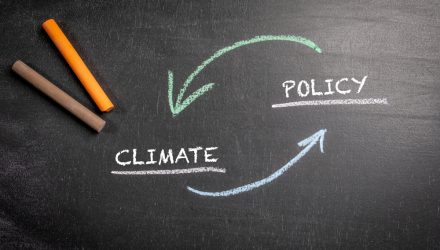Global carbon reduction and climate policy still lack uniformity at the regional level. But the U.S. is one of the leaders on those fronts. However, within the U.S., carbon policy isn’t yet uniform across the 50 states.
The federal government is attempting to do something about that. But for now, it’s clear that at the state level, California is an undisputed leader. That highlights the allure of the KraneShares California Carbon Allowance ETF (KCCA). KCCA, which turned two years old last month, follows the IHS Markit Carbon CCA Index. That gauge provides exposure to the California Carbon Allowances (CCA) cap-and-trade carbon allowance program.
For those not familiar with California or broader cap-and-trade jargon, KCCA is the premier avenue among ETFs for investors looking for efficient access to California’s well-documented carbon-reduction efforts. Investors who are not familiar with the merits of such a strategy might find comfort in the fact that KCCA is up 30.22% year-to-date. And it currently resides around 52-week highs.
Carbon Ambitions Highlight KCCA Potential
While many market participants might not yet be familiar with carbon investing, plenty have likely heard about the need to reduce carbon output and the related steps companies and governments around the world are taking to that effect.
“We estimate that energy sector carbon emissions will account for 70% of all U.S. carbon emissions by 2035 even if the U.S. hits the Biden Administration’s most aggressive clean energy targets,” noted Morningstar analyst Travis Miller. “We estimate energy sector emissions would fall to just 50% by 2035 if the U.S. followed the Paris Agreement’s 1.5 degrees Celsius global warming limit pathway to net-zero emissions by 2050.”
Carbon-related investment strategies such as KCCA could also offer long-term appeal because the White House’s plans to pare carbon output by 2035 could create gaps at the start of the next decade that need to be filled. That could require more financing, potentially driving more capital into the carbon credits market.
“We forecast only 65% carbon-free power generation by 2030, leaving a huge gap to fill between 2030 and 2035 to meet Biden’s target. More recent policymaking proposals from the administration suggest they think 2040 is a more realistic target, but we think even that is aggressive,” added Mille.
Further enhancing the allure of cap-and-trade programs, also known as Emissions Trading Systems (ETS), and thus KCCA, is the point that carbon allowances investing is a proven concept, but one that’s still young and gaining more traction among asset allocators. That could bode well for increased adoption of KCCA in the years ahead.
For more news, information, and analysis, visit the Climate Insights Channel.

